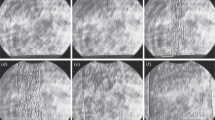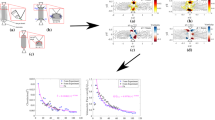Abstract
The spark method uses the fact that gas molecules which have been excited by the passage of a spark form a high conductance path for another high voltage pulse following the previous discharge after 10 to 100μs. A square pulse high voltage spark of duration adjustable down to 01μs is available.
To ensure that the first spark of a train is as nearly straight as possible, it is triggered by an alpha particle from a safe radioactive source, the alpha-particle track being finely collimated.
Stereoscopic photography of the sparks is used for observation, the pair of photographs being taken on a single 125×100 mm2 film. A Saab microdensitometer scanner is used for automatic recording of the co-ordinates of selected points on the stereo photograph and a data reduction computer program is used to obtain the three-dimensional positions of the spark paths and hence determine the flow velocities working from a known boundary condition.
Similar content being viewed by others
References
J.Herzog and J. R.Weske, University of Maryland Technical Note BN-105, July 1957.
J. R.Harrison, M.Sc. thesis, “Development of a spark discharge method of flow visualization”', University of Edinburgh, July, 1967.
Author information
Authors and Affiliations
Rights and permissions
About this article
Cite this article
Christie, J.C., Burns, J.G. & Ross, M.A.S. Development of a spark discharge method of flow measurement. Opto-electronics 5, 101–106 (1973). https://doi.org/10.1007/BF01421905
Received:
Issue Date:
DOI: https://doi.org/10.1007/BF01421905




